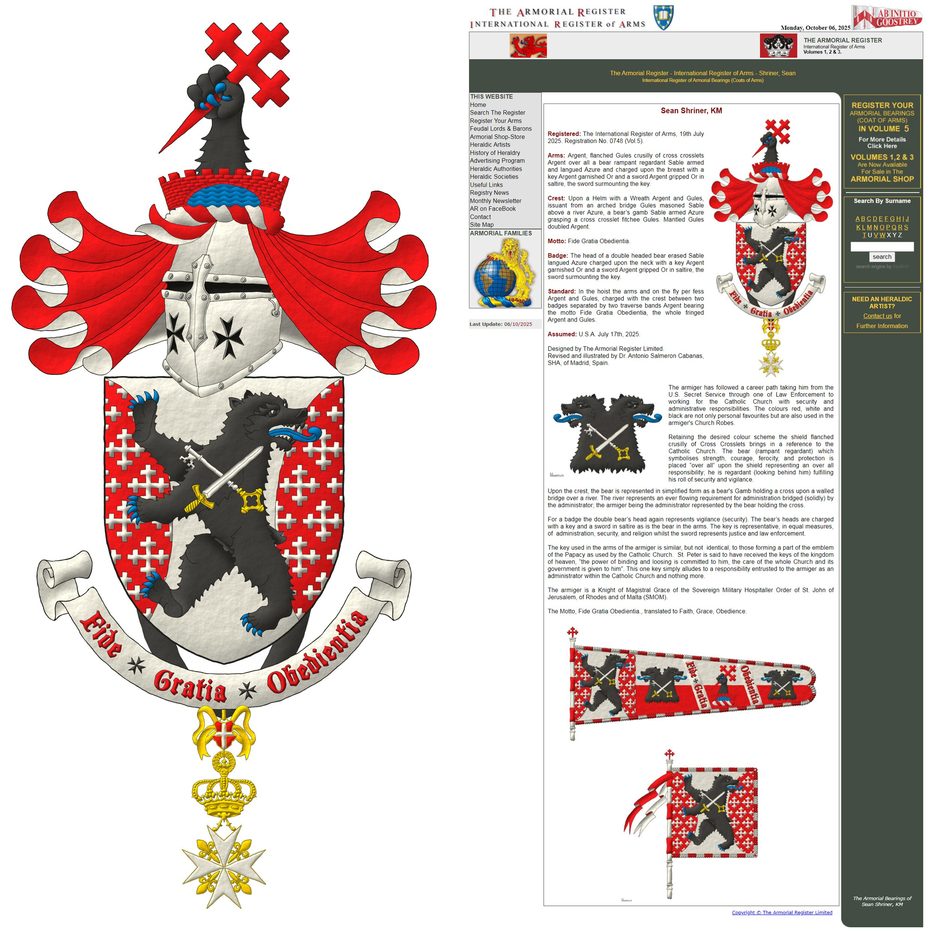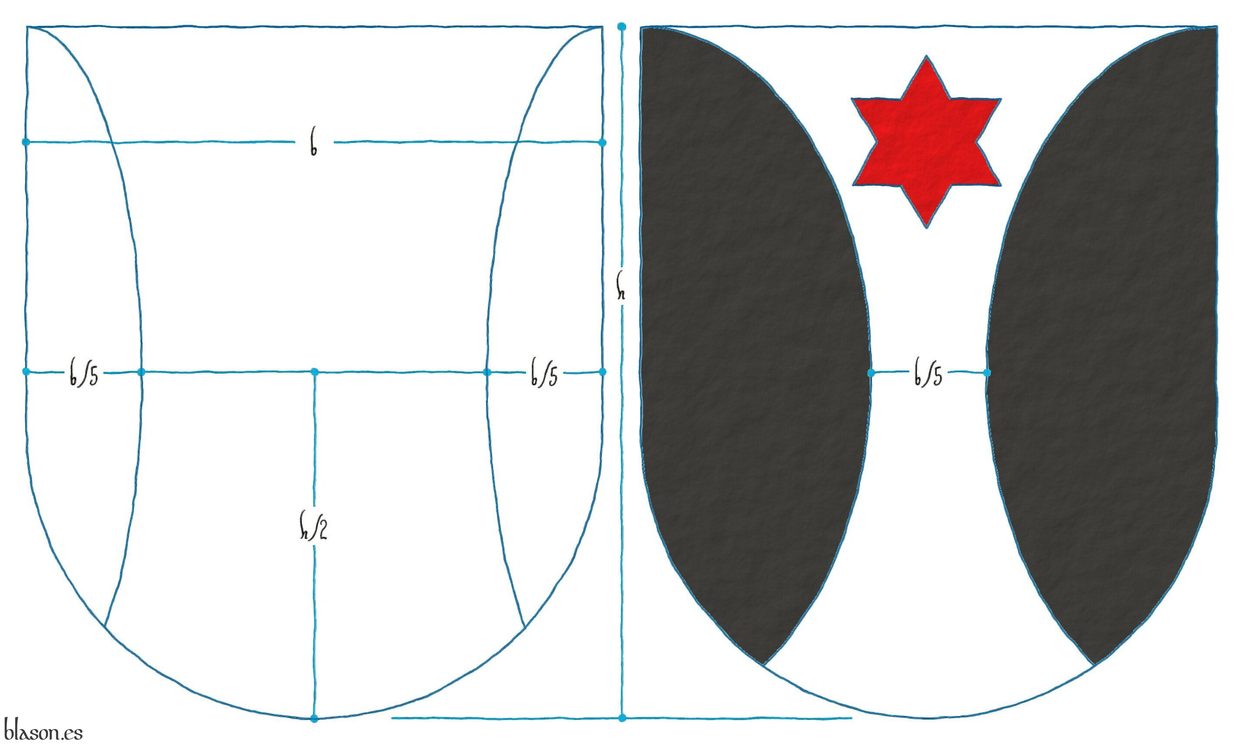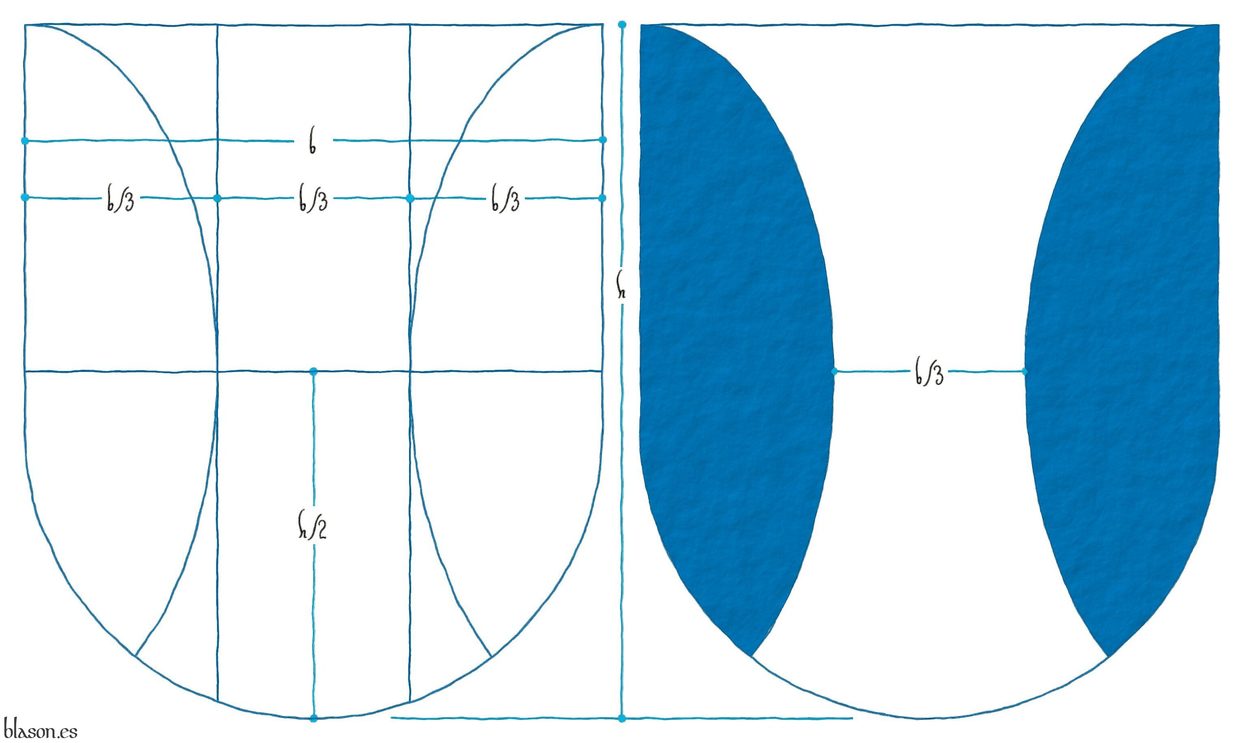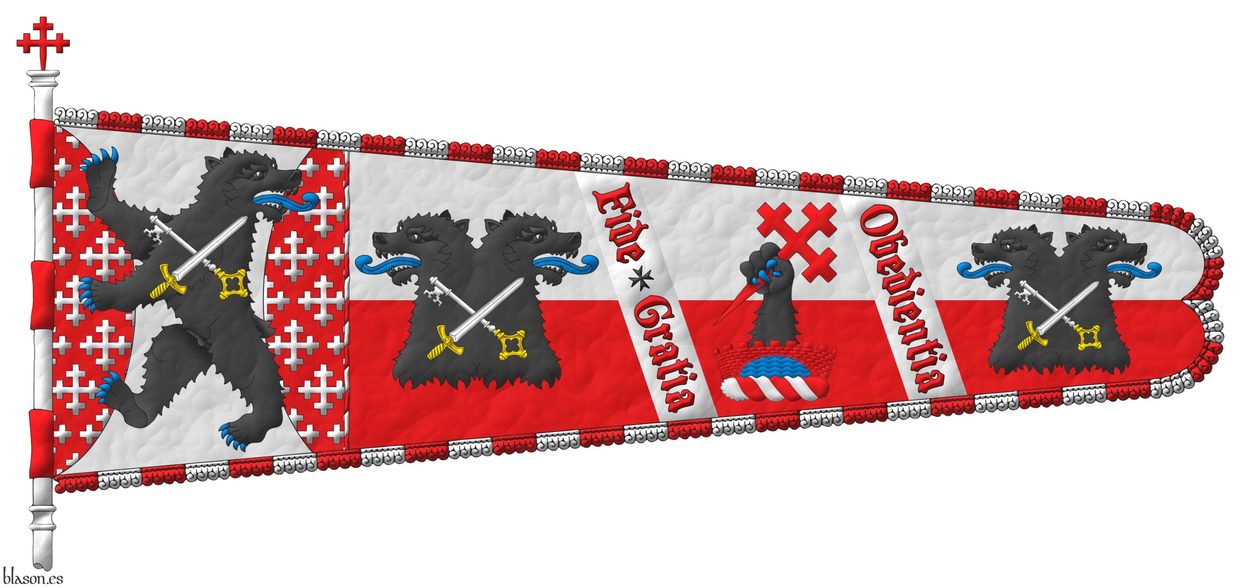Flanched


Arms of Del Fabbro Universidad with its motto in flat tincture
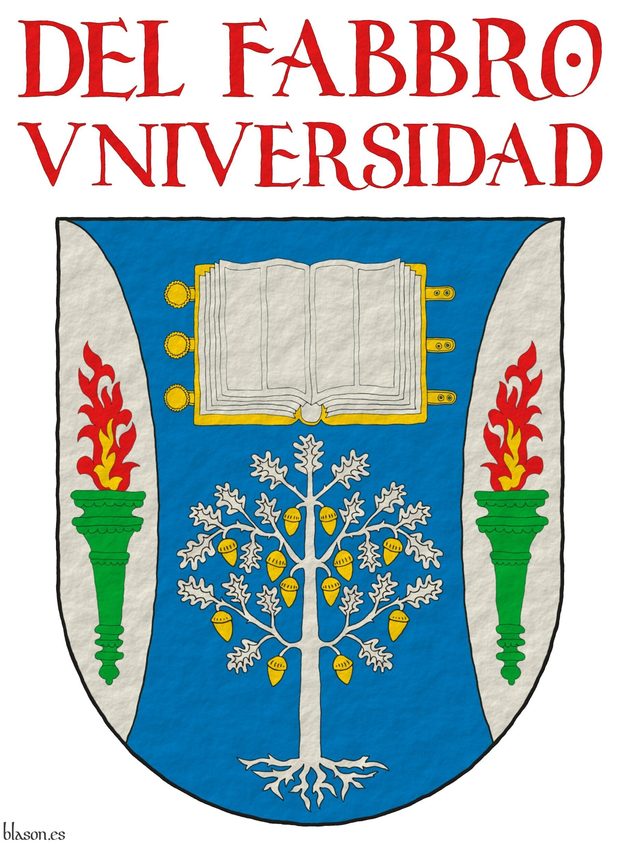
Azure, flanched Argent: in chief, an open book Argent, garnished Or; in base, an oak eradicated Argent, fructed Or; in each flank, a torch Vert, enflamed proper. Motto above the arms: «Del Fabbro Universidad» Gules.
Escudo de azur, flanqueado curvo de plata: en jefe, un libro abierto de oro, hojado de plata; en punta, un roble arrancado de plata, frutado de oro; en cada flanco, una antorcha de sinople, encendida al natural. Divisa sobre el escudo: «Del Fabbro Universidad» de gules.
Coat of arms designed by me, in flat tinctures, outlined in Sable, with a semi-circular external shape and with a texturized finish.
Blazon keywords: Azure, Argent, Or, Vert, Gules, One, Two, Flanched, In chief, Open book, Book, Garnished, In base, Oak, Tree, Eradicated, Fructed, In each flank, Torch, Enflamed, Proper, Motto and Above the shield.
Style keywords: Outlined in sable, Plain tincture and Semi-circular.
Classification: Socioeconomic, Created, Boa and Coat of arms.
Bearer: Del Fabbro Universidad.


Arms of Sean Shriner in the Armorial Register
Argent, flanched Gules crusilly of cross-crosslets Argent, overall a bear rampant regardant Sable, armed and langued Azure, charged with a key and a sword in saltire Argent, hilted Or, the key debruised by the sword. Crest: Upon a helm with a wreath Argent and Gules, issuant from a bridge, enarched, embattled Gules, masoned Sable above a river Azure, a bear’s forepaw Sable, armed Azure, grasping a cross crosslet fitchy bendwise sinister Gules. Mantling: Gules doubled Argent. Motto: «Fide Gratia Obedientia» Gules over a scroll Argent. Suspended from the shield the cross of Knight of Magistral Grace of the Sovereign Military Order of Malta.
Coat of arms of Sean Shriner, designed by The Armorial Register, and revised and emblazoned by me. The image combines his full achievement painted by me, and the web page of The Armorial Register, armorialregister.com/arms-us/shriner-s-arms.html, showing the heraldic registration of Sean Shriner’s full achievement, his heraldic badge, his heraldic standard, and his banner of arms, all painted by me for that register.
Blazon keywords: Argent, Gules, Sable, Azure, Or, One, Flanched, Semé, Cross-crosslet, Cross couped, Overall, Bear, Rampant, Regardant, Armed, Langued, Charged, Key, Sword, In saltire, Hilted, Debruised, Crest, Upon (wreath), Helm, Wreath, Issuant, Enarched, Bridge, Embattled, Masoned, Above, River, Forepaw, Grasping, Cross fitchy, Bend sinisterwise, Mantling, Doubled, Motto, Scroll, Suspended from the shield and Decoration.
Style keywords: Outlined in sable, Illuminated and Pointed.
Classification: Personal, Interpreted, Boa and Collage.
Bearer: Shriner, Sean.


Del Fabbro Universidad

Azure, flanched Argent: in chief, an open book Argent, garnished Or; in base, an oak eradicated Argent, fructed Or; in each flank, a torch Vert, enflamed proper.
Escudo de azur, flanqueado curvo de plata: en jefe, un libro abierto de oro, hojado de plata; en punta, un roble arrancado de plata, frutado de oro; en cada flanco, una antorcha de sinople, encendida al natural.
Coat of arms devised by me, illuminated with lights and shadows, contoured in Sable, with a semi-circular outer contour and with a metal beaten finishing.
Blazon keywords: Azure, Argent, Or, Vert, One, Two, Flanched, In chief, Open book, Book, Garnished, In base, Oak, Tree, Eradicated, Fructed, In each flank, Torch, Enflamed and Proper.
Style keywords: Outlined in sable, Illuminated, Semi-circular and Metal beaten.
Classification: Socioeconomic, Created, Boa and Coat of arms.
Bearer: Del Fabbro Universidad.


Del Fabbro Universidad, plain tincture
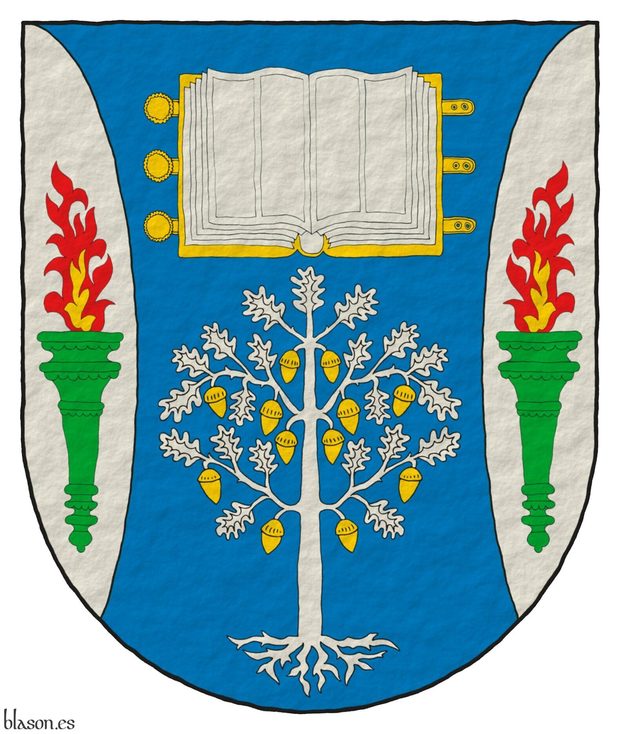
Azure, flanched Argent: in chief, an open book Argent, garnished Or; in base, an oak eradicated Argent, fructed Or; in each flank, a torch Vert, enflamed proper.
Coat of arms designed by me, in plain tinctures, contoured in Sable, with a semi-circular outer contour and with a texturized finish.
Coat of arms of Del Fabbro Universidad, Tlaxcala, Mexico, designed and emblazoned by me.
Blazon keywords: Azure, Argent, Or, Vert, One, Two, Flanched, In chief, Open book, Book, Garnished, In base, Oak, Tree, Eradicated, Fructed, In each flank, Torch, Enflamed and Proper.
Style keywords: Outlined in sable, Plain tincture and Semi-circular.
Classification: Socioeconomic, Created, Boa and Coat of arms.
Bearer: Del Fabbro Universidad.


Flanched, schemaat one-fifth
Outlines and proportions of a flanched design at one-fifth.
Regarding the flanched design, [Avilés, J.; 1725a; page 92] writes: «it is said of a figure that divides the Shield from the side of the flanks, sometimes by means of half-ovals», such as those in the diagram that illustrates this article, «and other times by means of half-lozenges, which run from the angle of the Chief to the angle of the base on the same side, whence they take their beginning».
In [Avilés, J.; 1725a; figure 197] an example of a flanched shield is illustrated with the arms of Oschoven on the Rhine, where the space left between both flanches is 1/5 of the base of the shield and, therefore, the width of each flank is 2/5 of the base of the shield, being 2/5 + 1/5 + 2/5 equal to the full base.
Blazon keywords: Flanched.
Style keywords: Semi-circular.
Classification: Schema.
Bearer: Oschoven of the Rhin.

![Ver [Flanched, schemaat one-third] en criterios utilizados. Unicornio saltante sobre la divisa, criterio.](../css/Unicornio.Criterio.png)
Flanched, schemaat one-third
Outlines and proportions of a flanched design at one-third.
This is my standardized way of delineating curved flanches, so that they remain tangent to a pale and, therefore, the width of both curved flanches and the space between them is equal to one third of the base. Some draw the flanches using circles, but I believe they look better as two half-ovals, which together would form a complete oval, with the height equal to that of the shield and the width two thirds of the base of the shield, that is, one third for each of the flanches, as in the figures illustrating this article. However, it should be noted that, depending on the charges, the separation distance may be adjusted.
Types of flanched designs
The «flanqueado curvo» corresponds to «flanched» in English, since for them the curved form is the default. [Avilés, J.; 1725b; page 92, figure 197] calls it «flanqueado en óvalo».
The «flanqueado apuntado» formed by 2 opposed triangles I call «pointed flanched» in English, as I have not found a better term. [Avilés, J.; 1725b; page 92, figure 198] calls it «flanqueado en sotuer», but what he draws in his book actually corresponds to a «cuartelado en sotuer» since the two points of the flanking meet at the center of the coat of arms.
«Flanqueado» without adjectives corresponds in Castilian to an «adiestrado» as opposed to a «siniestrado», and I refer to it in English as «flanked by two pales» having found no better translation.
Blazon keywords: Flanched.
Style keywords: Semi-circular.
Classification: Criterion and Schema.
Bearer: Oschoven of the Rhin.


Oschoven of the Rhin
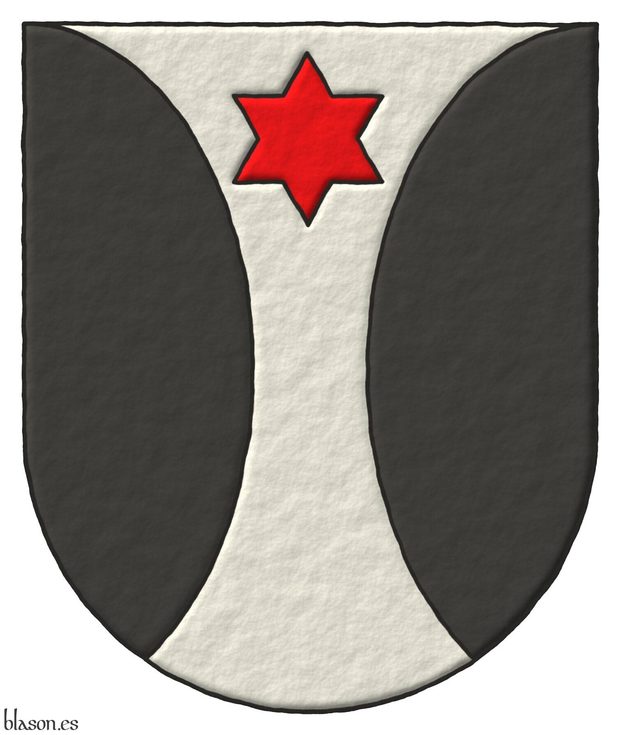
Argent, flanched Sable, in chief a mullet of six points Gules.
Escudo de plata, flanqueado curvo de sable, en jefe una estrella de seis rayos de gules
Coat of arms interpreted with: a semicircular (round) base; illuminated in the tinctures Argent, Gules, and Sable; all outlined in Sable; and finished with a raised-stroke effect.
[Avilés, J.; 1725a; pages 92 and figure 197] blazons it as «Argent, and a six-pointed star Gules in chief, flanched in oval Sable». When he illustrates it in [Avilés, J.; 1725a; figure 197], the space left between both flanches is only 1/5 of the base of the coat of arms; this is feasible because the only charge is a mullet in chief. If there were more charges, it would be necessary to leave more space, for example, 1/3 of the base of the shield.
«Oschoven au Rhein» in the book [Menestrier, C. F.; 1659; page 315], it is blazoned «d'argent flanqué arrondi de sable à vne molette de mesme en chef», so the mullet would be Sable, bacause «de mesme» is written, and with a hole in the middle, this hole does not exits in other sources.
In the book [Rietstap, J. B.; 1861], it is blazoned «Argent, flanched in round Sable, Argent charged in chief of a mullet Gules», and in French «d'argent, flanqué en rond de sable, l'argent chargé en chef d'une étoile de gueules».
Some time ago I used to blazon it in English as «Argent, in chief a mullet of six points Gules, between two flanches Sable».
Blazon keywords: Argent, Sable, Gules, Mullet, Chief and Flanched.
Style keywords: Semi-circular, Illuminated, Outlined in sable and Freehand.
Classification: Interpreted and Personal.
Bearer: Oschoven of the Rhin.


Shriner, Sean
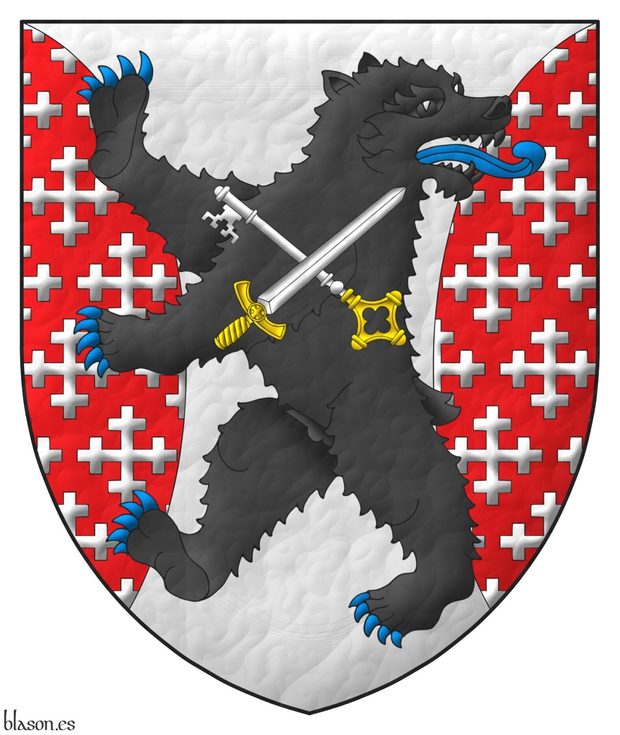
Argent, flanched Gules crusilly of cross-crosslets Argent, overall a bear rampant regardant Sable, armed and langued Azure, charged with a key and a sword in saltire Argent, hilted Or, the key debruised by the sword.
Escudo de plata, flanqueado curvo de gules sembrado de cruces recrucetadas de plata, brochante sobre el todo un oso rampante y contornado de sable, armado y lampasado de azur, cargado de una llave y una espada en sotuer de plata, ambas guarnecidas de oro y la llave resaltada de la espada.
Coat of arms emblazoned by me, illuminated with lights and shadows, outlined in Sable, with a pointed external shape and with a leather finishing.
Coat of arms of Sean Shriner, designed by The Armorial Register, and revised and emblazoned by me. The expression «crusilly of cross-crosslets» is equivalent to «semé of cross-crosslets», and in either case, in Spanish it is rendered as «sembrado de crucetas».
Blazon keywords: Argent, Gules, Sable, Azure, Or, One, Flanched, Semé, Cross-crosslet, Cross couped, Overall, Bear, Rampant, Regardant, Armed, Langued, Charged, Key, Sword, In saltire, Hilted and Debruised.
Style keywords: Outlined in sable, Illuminated, Pointed and Leather.
Classification: Personal, Interpreted, Boa and Coat of arms.
Bearer: Shriner, Sean.


Standard Sean Shriner
Heraldic device emblazoned by me, illuminated with lights and shadows, contoured in Sable, with a pointed outer contour and with a leather finish.
Heraldic standard of Sean Shriner, designed by The Armorial Register, and revised and emblazoned by me. Structure: Coat of arms; Badge; 1st line of the motto «Fide Gratia»; Crest; 2nd line of the motto «Obedientia»; Badge.
Blazon keywords: Argent, Gules, Sable, Azure, Or, Flanched, Semé, Cross-crosslet, Cross couped, Overall, Bear, Rampant, Regardant, Armed, Langued, Charged, Key, Sword, In saltire, Hilted, Debruised, Crest, Upon (wreath), Wreath, Issuant, Enarched, Bridge, Embattled, Masoned, Above, River, Forepaw, Grasping, Cross fitchy, Bend sinisterwise, Double-headed and Erased.
Style keywords: Outlined in sable, Illuminated, Pointed and Leather.
Classification: Personal, Interpreted, Boa, Standard and Flag.
Bearer: Shriner, Sean.
-
Language
-
Categories of heraldry
-
Divisions of the field
- Without divisions
- Party per pale
- Party per fess
- Party per bend
- Party per bend sinister
- Tierce
- Tierce sinister
- Tierced per pale
- Tierced per fess
- Tierced per bend
- Tierced pallwise inverted
- Quarterly
- Quarterly per saltire
- Gyronny
- Party per fess, the chief per pale
- Party per pale, the sinister per fess
- Party per fess, the base per pale
- Party per pale, the dexter per fess
- Chapé
- Chaussé
- Embrassé
- Contre-embrassé
- Party per chevron
- Enté
- Enté en point
- Flanched
-
Metals
-
Colours
-
Furs
-
Other tinctures
-
Ordinaries and sub-ordinaries
-
Diminutives of the ordinaries
-
Geometric charges
-
Composite ordinaries
-
Inanimate charges from Nature
Atom, Crescent, Diamond, Emerald, Estoile, Increscent, Lightning flash, Moon, Mount, Mullet, Mullet of four points, Orbital, Plough of Ursa Major, Rainbow, Ray of the sun, River, Sea, Snowflake, Sun, Sun in splendour, Sun of May, Trimount and Water.
-
Vegetal charges from Nature
Acorn, Apple, Apple tree, Ash, Bluebonnet, Camellia, Chrysanthemum, Cinquefoil, Cornflower, Dogwood flower, Double rose, Elm, Fleur de lis, Flower, Holm oak, Hop cone, Kapok tree, Laurel, Lily, Linden, Lotus flower, Madonna lily, Oak, Olive tree, Palm tree, Pomegranate, Poplar leaf, Rose, Shamrock, Sunflower, Thistle, Tree, Tulip, Vine and Wheat.
-
Animal charges from Nature
Badger, Bald eagle, Barbel, Barn owl, Bear, Beaver, Beetle, Bighorn sheep, Blackbird, Boar, Brach hound, Bull, Doe, Dog, Dolphin, Dove, Eagle, Elephant, Falcon, Fish, Flame, Fly, Fox, Frog, Goat, Goldfinch, Goose, Heron, Horse, Hummingbird, Jaguar, Lark, Leopard, Lion, Lion passant, Lion rampant guardant, Lioness, Lynx, Male figure, Martlet, Merino ram, Owl, Panther, Parrot, Peacock, Pelican, Pelican in her piety, Puffin, Quetzal, Raven, Roe deer, Rooster, Savage, Seagull, Serpent, She-wolf, Stag, Starling, Talbot, Tyger, Vulture, Warren hound and Wolf.
-
Parts of natural charges
Arm, Beak, Branch, Caboshed, Chest, Claw, Covert, Dorsal fin, Eagle claw, Ermine spot, Escallop, Feather, Foot (palmiped), Foreleg, Forepaw, Hand, Head, Heart, Hoof, Leaf, Neck, Ostrich feather, Palm frond, Paw, Roe deers' attires, Shoulder, Sprig, Stags' attires, Stem, Swallow-tail, Tail, Tail addorsed, Tail fin, Talon, Tooth, Trunk, Trunk (elephant), Two hands clasped, Two wings in vol, Udder, Wheat spike, Wing and Wrist.
-
Artificial charges
Ace of spades, Anchor, Anvil, Arch, Arm vambraced, Armillary sphere, Arrow, Axe, Bell, Bell tower, Beret, Bonfire, Book, Bookmark, Bow, Bridge, Broken, Buckle, Cannon, Cannon dismounted, Cannon port, Canopy roof, Carbuncle, Castle, Celtic Trinity knot, Chain, Chess rooks, Church, Clarion, Clay pot, Closed book, Club, Comb, Compass rose, Conductor's baton, Cord, Covered cup, Crozier, Crucible, Cuffed, Cup, Cyclamor, Dagger, Double vajra, Drum, Ecclesiastical cap, Fanon, Federschwert, Fleam, Four crescents joined millsailwise, Galician granary, Garb, Gauntlet, Geometric solid, Grenade, Halberd, Hammer, Harp, Host, Hourglass, Key, Key ward, Knight, Knot, Lantern, Letter, Line, Loincloth, Menorah, Millrind, Millstone, Millwheel, Monstrance, Mortar, Mullet of six points pierced, Nail, Non-classic artifact, Norman ship, Number, Oar, Oil lamp, Open book, Page, Pair of scales, Parchment, Pestle, Piano, Plough share, Polish winged hussar, Port, Portcullis, Potent, Quill, Ribbon, Rosette of acanthus leaves, Sabre, Sackbut, Sail, Scroll, Scythe, Sheaf of tobacco, Ship, Skirt, Spear, Spear's head, Stairway, Star of David, Step, Sword, Symbol, Tetrahedron, Torch, Tower, Trident, Trumpet, Turret, Two-handed sword, Wagon-wheel, Water-bouget, Wheel, Winnowing fan and With a turret.
-
Immaterial charges
Angel, Archangel, Basilisk, Dragon, Dragon's head, Garuda, Golden fleece, Griffin, Heart enflamed, Mermaid, Our Lady of Mercy, Ouroboros, Paschal lamb, Pegasus, Phoenix, Sacred Heart of Jesus, Saint George, Sea-griffin, Trinity, Triton, Unicorn, Winged hand and Wyvern.
-
External elements
-
Heraldic creations
-
References
-
Formats
-
Keywords on this page
Garnished, Proper, Torch, Pointed, Armed, Eradicated, Azure, Boa, Overall, Charged, Regardant, Created, Cross couped, Cross-crosslet, Del Fabbro Universidad, Outlined in sable, Two, In each flank, In chief, In base, In saltire, Coat of arms, Sword, Flanched, Fructed, Personal, Hilted, Gules, Illuminated, Interpreted, Langued, Book, Open book, Enflamed, Key, Semi-circular, Or, Oschoven of the Rhin, Bear, Argent, Rampant, Debruised, Oak, Sable, Semé, Shriner, Sean, Vert, Socioeconomic and One.

